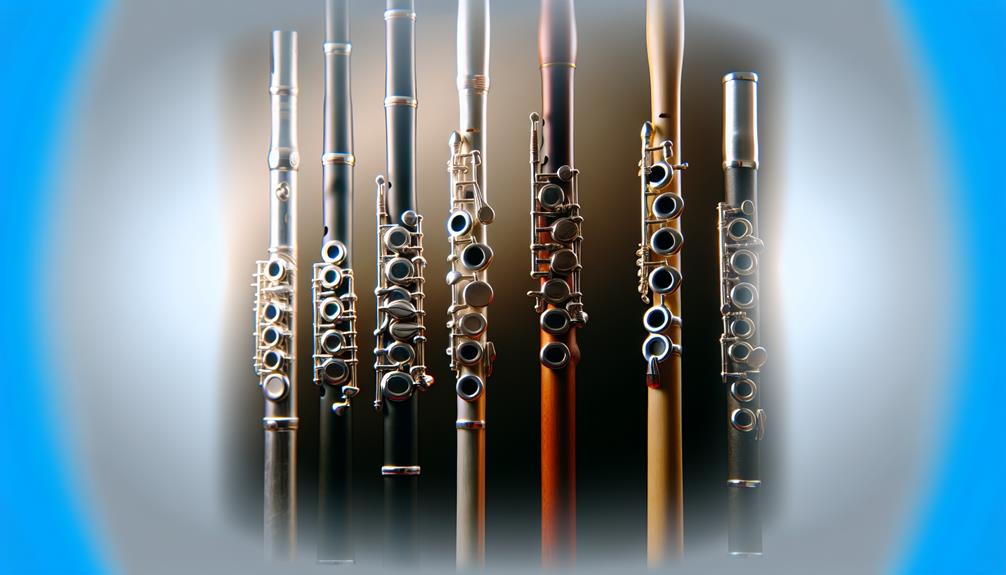When it comes to the world of music, the quest for the perfect tone is a never-ending pursuit among musicians and enthusiasts alike.
In the realm of flutes, the debate over which instrument produces the best tone is a topic that has intrigued many. From the material of the flute to the intricacies of its design, various factors play a role in shaping the sound that emanates from this elegant instrument.
Stay tuned as we delve deeper into the nuances of flute tone production, exploring the complexities that set apart one flute's tone from another.
Key Takeaways
- Silver flutes provide bright and focused tones, ideal for clarity and precision.
- Gold flutes offer warm and rich sound quality, perfect for a lush and full-bodied tone.
- Wooden flutes produce organic, unique tones with a warm and earthy quality.
- Headjoint design significantly impacts flute tone, influencing playability and overall sound.
Factors Affecting Flute Tone
Several key factors significantly influence the tone produced by a flute, including the material of construction, design intricacies, and the player's technique.
The material of construction plays a crucial role in determining the overall sound quality of a flute. Common materials used in flute-making include silver, gold, nickel, and various types of wood. Each material has its unique characteristics that affect the tone produced, with silver and gold often favored for their richness and warmth.
Design intricacies also play a vital part in shaping the flute's tone. Factors such as the shape and size of the flute's body, the type of keys used, and the mechanism of tone production all contribute to the instrument's overall sound. A well-designed flute can enhance the tonal quality and playability, making it more appealing to both the player and the listener.
Furthermore, the player's technique is instrumental in producing a beautiful tone. Proper breath control, embouchure, finger placement, and articulation all influence how the flute sounds. A skilled player can draw out the full potential of a flute, creating a rich, resonant tone that captivates the audience.
Comparing Different Flute Materials
The choice of material in flute construction significantly influences the instrument's tone quality and overall performance. Flutes are commonly made from materials such as silver, gold, nickel silver, and various types of wood.
Silver flutes are favored for their bright and focused sound, making them popular among classical musicians. Gold flutes, on the other hand, are known for their warm and rich tones, often preferred by players seeking a more mellow sound. Nickel silver flutes offer a balance between silver and gold, providing a versatile option for a wide range of musical styles.
Wooden flutes produce a unique, organic sound prized by traditional and folk musicians. Each material brings its own characteristics to the instrument, influencing factors such as projection, response, and tonal color. When choosing a flute, consider the type of music you will be playing and the sound quality you desire to find the material that best suits your needs and preferences.
Examining Flute Headjoint Designs
Different flute headjoint designs play a crucial role in shaping the instrument's tone and playability. The headjoint is the part of the flute where the player blows air into the instrument, creating sound. Various headjoint designs offer unique characteristics that can affect the overall tonal quality and response of the flute.
One common headjoint design is the traditional lip plate headjoint, which features a lip plate where the player directs the air stream. This design is known for its balanced response and versatility, making it a popular choice among flutists of all levels.
Another popular design is the wave headjoint, which incorporates a wave-like shape to improve airflow and enhance projection. This design is often favored by advanced players looking for a more dynamic and responsive sound.
Exploring Key Mechanisms Impacting Tone
Examining the intricate interplay of key mechanisms within flute construction unveils the critical factors influencing the instrument's tonal characteristics. These mechanisms play a vital role in shaping the sound produced by the flute, contributing to its overall tone quality.
Here are some key mechanisms impacting the flute's tone:
- Embouchure Hole Shape: The shape and size of the embouchure hole significantly affect the airflow and how the air splits against the edge, influencing the tone produced.
- Material Composition: The material the flute is made of, whether silver, gold, or other metals, can impact the resonance and timbre of the instrument.
- Keywork Design: The design and precision of the keys affect how well they seal the tone holes, influencing the clarity and projection of the sound.
- Mechanical Integrity: The overall construction quality and precision of the flute's mechanisms can impact the instrument's responsiveness and tonal consistency.
Understanding these key mechanisms is essential for achieving optimal tone production on the flute, as they all contribute to the unique sound characteristics of each instrument.
Tips for Achieving Optimal Flute Tone
To enhance the tonal quality of your flute playing, consider implementing these expert tips for achieving optimal flute tone.
Firstly, focus on your breath control. A steady stream of air is crucial for producing a rich and resonant sound. Practice long tones to develop your breath support and control.
Secondly, pay attention to your embouchure. The way you shape your lips and position your mouthpiece greatly impacts your tone. Experiment with different embouchure positions to find what works best for you.
Additionally, work on your finger technique. Clean and precise fingerings can help you play with more accuracy and consistency, leading to a clearer tone.
Lastly, regularly maintain your flute. Clean your instrument, change worn-out pads, and ensure proper lubrication of keys to keep your flute in optimal playing condition. By following these tips and dedicating time to practice, you can unlock the full potential of your flute's tone.
Frequently Asked Questions
Can the Tone of a Flute Be Improved Through Regular Maintenance and Cleaning?
Regular maintenance and cleaning can indeed improve the tone of a flute. Dust and debris can affect the instrument's sound quality. By keeping the flute in good condition, players can ensure optimal performance and a more resonant, clear tone.
Are There Specific Techniques or Exercises That Can Help a Player Develop a Richer Tone on the Flute?
Developing a richer tone on the flute involves exploring techniques like proper embouchure formation, breath control, and focused air stream. Regular practice of long tones, lip slurs, and tone exercises can significantly enhance a player's sound quality and expression.
How Do Environmental Factors Such as Temperature and Humidity Affect the Tone of a Flute?
Environmental factors like temperature and humidity can significantly impact a flute's tone. Fluctuations in these conditions can affect the instrument's materials and mechanism, leading to variations in sound quality. Proper care and maintenance help mitigate these effects for consistent performance.
Is There a Difference in Tone Quality Between Flutes Made by Different Manufacturers, Even if They Are Made of the Same Material?
Flutes crafted by different manufacturers, despite sharing the same material, can exhibit variations in tone quality. Factors like design, craftsmanship, and individual characteristics of each flute can contribute to the distinct tonal nuances perceived by players and listeners.
Can the Age of a Flute Impact Its Tone Quality Over Time?
As time weaves its intricate threads around a flute, the aging process can subtly influence its tone quality. Factors such as material degradation, wear on key mechanisms, and changes in wood density may contribute to a shift in the flute's sound.
Conclusion
In conclusion, the tone of a flute is influenced by various factors such as the material of the flute, the design of the headjoint, and the mechanisms of the keys.
While different flutes may have varying tones, the best tone ultimately depends on the preferences and playing style of the individual musician.
By understanding these factors and experimenting with different options, musicians can work towards achieving an optimal flute tone that suits their needs and preferences.

